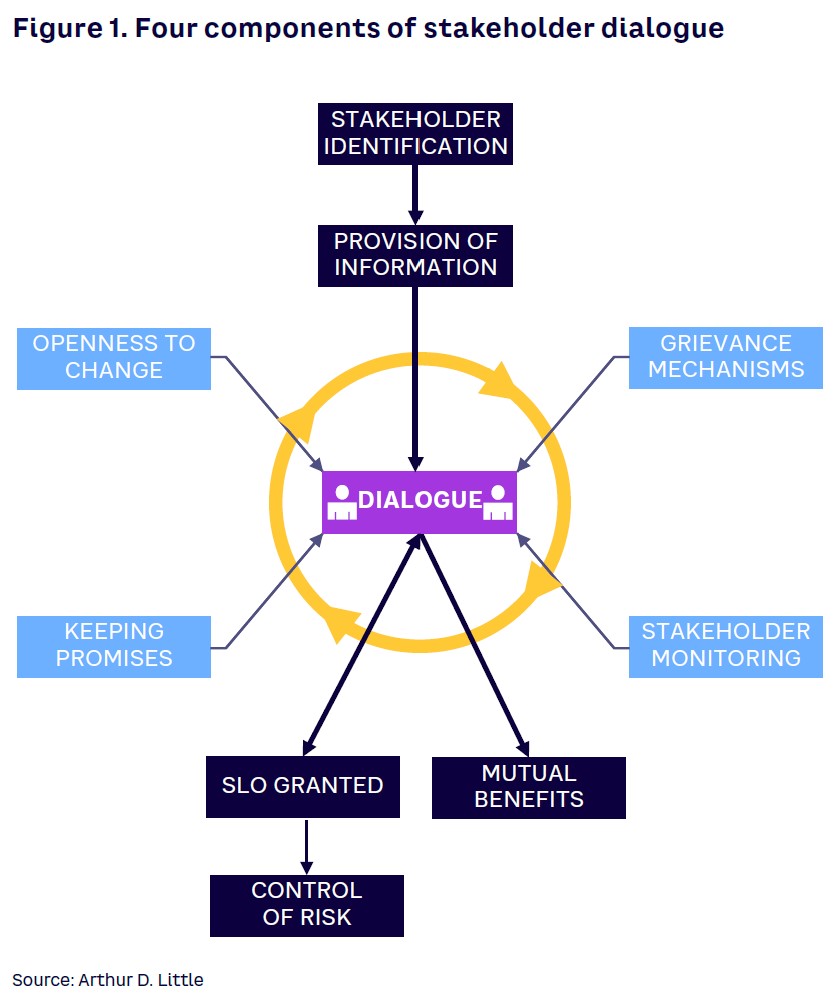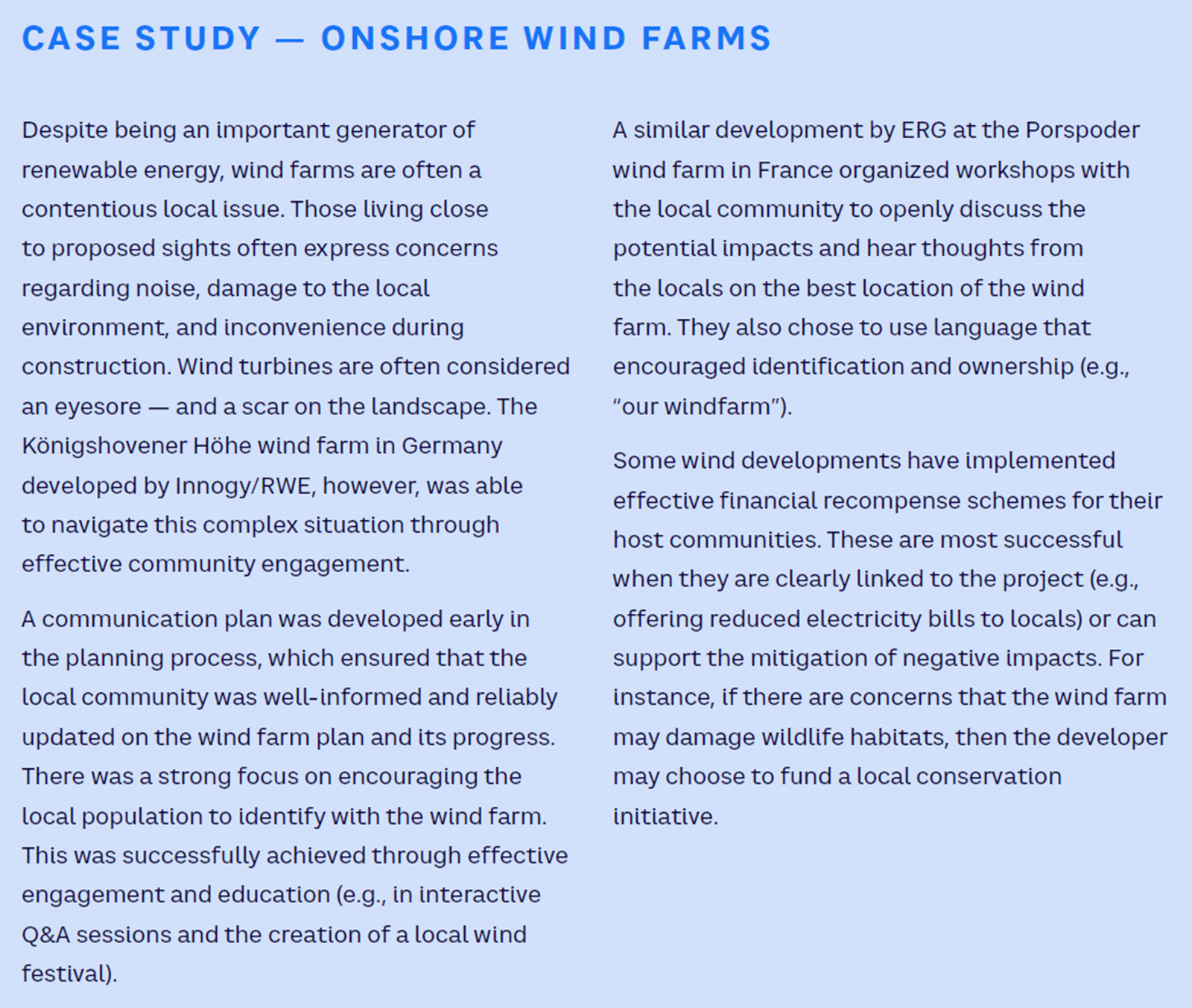
The social license to operate
With sustainability at the forefront of today’s business activity, companies must adapt to deliver on stakeholder expectations. ESG (environmental, social, and governance) reporting is commonplace for many institutions and may even become a formal requirement. However, when considering ESG factors, our experience tells us that social issues are comparatively less well understood, with associated risks often poorly managed. Social factors are inherently complex and can be difficult to define, hard to understand, and almost impossible to quantify or measure. The concept of the “social license to operate” (SLO) was borne out of a need to frame this complicated and neglected dimension for major business projects.
The SLO has been granted various overlapping definitions; put simply, it is a measure of stakeholder acceptance of a project or undertaking, sufficient to allow the project to progress according to plan, on the basis that it continues to meet stakeholder expectations. Such a “license” is unwritten and neither formally granted nor reliably measured. However, it is a useful concept when developing an understanding of stakeholder perceptions — and how they can be influenced to control social risk.
Hard to earn, easy to lose
The SLO is often best understood in its absence. Stakeholder disapproval (and a withheld license) can present serious, if not catastrophic, risk to a project. Objection can quickly hinder project progress (e.g., through planning application processes), and social outrage may even be sufficient to motivate an opposition campaign.
Stakeholder acceptance and approval can often be very difficult to achieve, requiring months or years of relationship building. When a social license is granted, it is often in the form of tolerance rather than enthusiasm, leaving it vulnerable to withdrawal. The SLO is dynamic and must not only be earned but proactively maintained. In the most extreme cases, such as the Jukkan Gorge example (see case study), the social license, strengthened over decades, can be lost in an instant.

The costs associated with the absence of a social license can be severe and materialize as delayed production (and associated loss in sales), legal fees, security, reputation and shareholder confidence, and opportunity cost (e.g., for future expansion), among others. For instance, a single protest cost the UK’s High Speed 2 (HS2) rail project £3.5 million, while PNAS estimates that delayed production at a large mine can incur costs of US $20 million per week.
Beyond corporate social responsibility
Many executives may think that they are managing social risks through corporate social responsibility (CSR) policies and initiatives, but this is fallacious. CSR is too often a public relations exercise that will not materially impact the achievement of a social license. The problems with CSR policy are manifold:
- CSR is generally seen as external to core business activities, whereas building an SLO is a vital part of project development.
- Often CSR activities are, or are perceived as, tokenistic and do not effectively mitigate social impacts.
- CSR is too often implemented as a short-term fix to stakeholder demands and does not incorporate the foresight necessary to maintain the social license in the long term.
Moreover, philanthropy is not considered best practice when it comes to achieving an SLO. It is important to consider the social license not as a means of reducing resistance but as a long-term commitment to working with stakeholders to manage expectations and bring about mutual net benefit. Consider for example, a donation to a local charity. Though well-intentioned, this may be perceived as an attempt to “buy” favor and will be unlikely to offset any negative impacts. Instead, actions such as employing local people and procuring local services are in the long-term interest of both parties and thus more likely to build stable support. A step further may see projects offering shared ownership to communities whereby they receive, for example, a share of the profits in return for hosting the site.
Effective community engagement
In most cases, the community local to a project has the greatest right to be involved in decision making and, similarly, can also have the greatest impact on the project. The key to gaining and maintaining an SLO is building relationships through community engagement.
Identifying stakeholders
No community has a cohesive, homogenous voice. The first step in the process is to identify stakeholder groups that share common worldviews, ambitions, and values. This enables an understanding of the social, cultural, and political environment from which one can anticipate potential concerns and inform the engagement approach. If possible, identify individuals who may act as representatives for groups, such as local politicians or councilors. Particular care must be given to identifying minority and marginalized groups, such as indigenous peoples who may be less able to represent themselves but whose cause is more likely to be taken up by external players.
Providing information
Stakeholders must be provided with sufficient detail that allows them to build informed views. Thus, businesses must be fully transparent — any aims to hide information will only inhibit the process if exposed in the future, and any sense of trust will likely collapse. Moreover, stakeholders must be informed on the engagement process so that their expectations are managed and the ways in which they can be involved is clear (e.g., by providing designated points of contact). Businesses should utilize a range of media to ensure sufficient reach and thus maximize inclusivity: online, social media, leafleting, and local news, among others.
Stakeholder dialogue
Dialogue is a two-way exchange, requiring input and listening from both parties. For dialogue to be constructive, it must be authentic and collaborative with both sides engaging openly and responsively.
As Figure 1 illustrates, there are four important components that feed the stakeholder dialogue process:
- Openness to change. Businesses must prepare themselves to adapt projects and activities as a result of engaging with stakeholders; otherwise, the whole process is inconsequential. To build credibility, it’s important to demonstrate this early.
- Keeping promises. A key component of the SLO is trust. The community must trust that the business will keep its word or else the dialogue will break down.
- Grievance mechanisms. The way in which a project deals with stakeholder complaints and objections largely impacts the tone and thus outcomes of the dialogue. It is important to design formal grievance mechanisms whereby stakeholders can be heard, misdemeanors acknowledged, and solutions sought. Poor response to complaints often leads to dissatisfaction being expressed through other, more public channels such as social media.
- Stakeholder monitoring. While engaging with communities, it is vital to monitor stakeholders and their evolving perceptions of a project. Tracking this allows the business to preempt concerns and adapt the approach accordingly. The business should integrate social risks into the organization’s key risk indicators (KRIs), triggering action when risk is beyond the risk appetite.

A successful community engagement strategy (see case study of onshore wind farms) controls social risk through prevention and mitigation of social impacts with corresponding benefits for the community. Engagement should be maintained throughout the project lifecycle, with the strategy adapted accordingly to ensure that actions are keeping up with developing social attitudes and concerns. Regular consultation workshops are a simple means to sustain the conversation.

Engaging with a global, networked community
Acceptance from the local community may no longer be sufficient to secure a social license. Innovations in communications technology have connected a global community and transformed the business environment. Social media, in particular, provides an unrivaled platform for sharing information and opinions and mobilizing action groups. One tweet from an influencer, or a viral video, can have immediate, wide-reaching, and potentially catastrophic impacts. Paired with the growing trend for socially conscious consumerism and political activism, there exists a rapidly evolving social risk.
International visibility means that it is possible, and common, for not only locals but individuals, NGOs, and campaign groups from across the world to object to a project. This vast pool of stakeholders is likely to present an even more diverse set of attitudes and expectations, often more ideological in nature. Such groups may exist to support and back up local communities but frequently act to further their own, separate cause. These groups are generally better resourced with louder voices than local communities, with the ability to damage wider business reputation beyond that of a single project.
Social media can also be dangerous territory for companies trying to manage social risk. Though it can be a highly effective way to interact with stakeholders, it must be managed with great care. There is neither a structure to the debate nor accountability for what is said and as exposed during the COVID-19 pandemic, misinformation is rife. NGOs and campaign groups have been quick to take advantage; they are savvy and highly able to manipulate information and influence users to an extent that most businesses cannot match.
Compared to local communities, identification of stakeholder groups across this global network is a more complicated task, and there is not the same opportunity to lay the foundations of the discussion. Engagement on social media thus requires a more nuanced approach, with particular attention paid to the following factors (see Figure 2):
- Transparency. Stick to the facts and be consistent. It is too easy for an opposition to highlight discrepancies and expose exaggerations.
- Neutrality. It is best practice not to polarize the discussion; hold the middle ground and avoid emotive language. Celebrate achievements and milestones but be sensitive to the perspective of others and do not gloat.
- Adaptability. Use available tools to track reach and engagement. Tailor approach accordingly (e.g., through targeted and time-appropriate messaging).

It is vital to be responsive. This does not mean reacting to every provocation and taunt but instead replying swiftly and efficiently to genuine concerns and complaints. A poorly maintained social media presence is open to exploitation by the opposition and is often worse than no presence at all. For this reason, accounts should be actively managed by knowledgeable staff that are trained in communications best practice — it is not a role for the office intern.
conclusion
Insight for the Executive
Social risk is no longer an optional element to a project’s risk mitigation strategy. CSR rhetoric will not be sufficient to secure the necessary acceptance from local and global stakeholders that will allow a project to progress without conflict and the associated lost time and costs. Local communities need to see a meaningful share of project benefits, along with genuine mitigation of negative impacts.
In today’s connected world, it is no longer enough to consider only the risks posed by just the local populace. Concerns that arise locally can rapidly escalate to a global audience with a diverse range of views and ambitions. This requires an adapted approach with a carefully managed use of social media platforms.
To gain and maintain a social license — and control social risk — businesses should:
- Design strategies for engaging with stakeholders that promote active engagement from an early stage in the project lifecycle.
- Be dynamic and responsive to evolving stakeholder expectations.
- Develop in-house digital literacy and approach social media with calculated caution.
- Prioritize delivering mutual benefits over philanthropy and tokenistic gestures.


